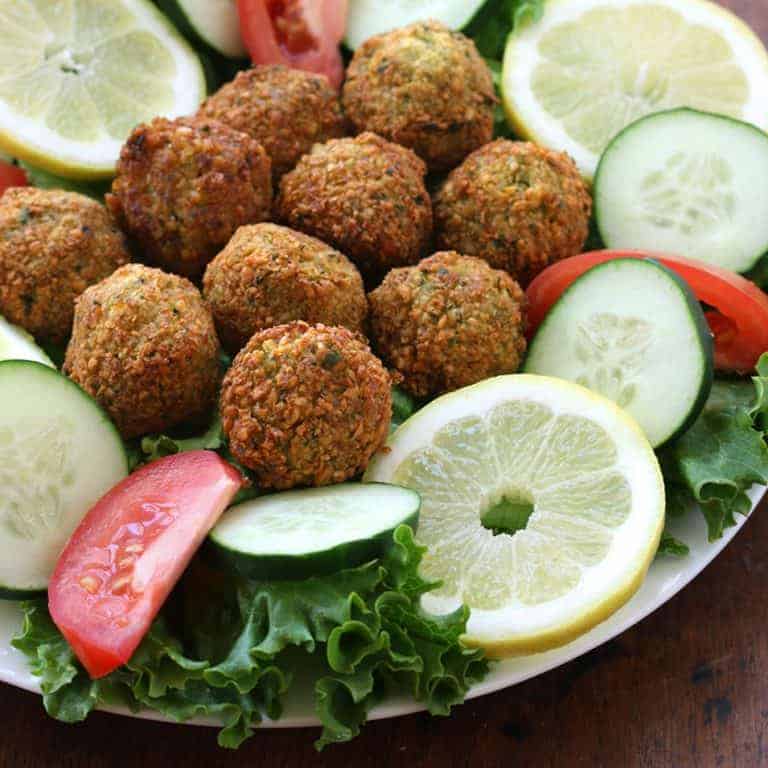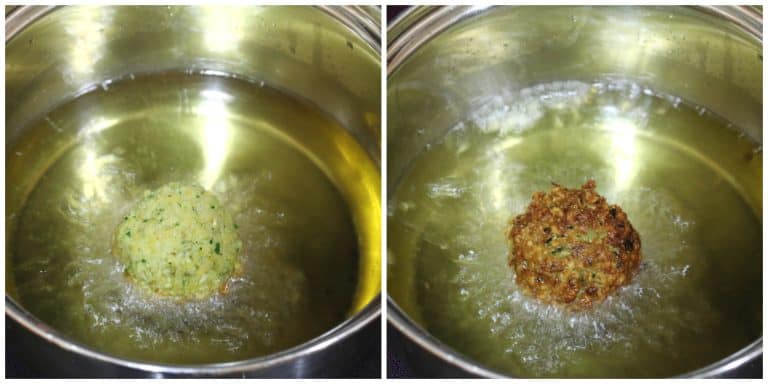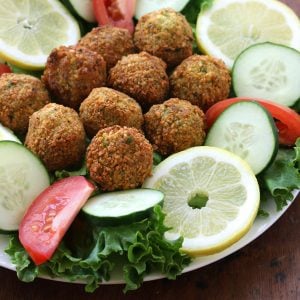BEST Authentic Falafel
This post may contain affiliate links. See my disclosure policy.
Look no further for the BEST falafel recipe made in authentic fashion and bursting with flavor! With a fabulous flavor and texture, these authentic falafel are not only highly nutritious, they’re incredibly delicious! Naturally vegetarian, vegan and gluten free. We’re confident you’ll agree this is the BEST falafel recipe you’ve tried!

If you’re not already familiar with falafel, it’s time you become acquainted. There is a reason why falafel has been a favorite throughout Jewish and Muslim communities across the globe for centuries – the moment you try them you’ll be hooked!
These fried chickpea balls have a wonderful texture and fantastic flavor. The toasted cumin and coriander a smoky flavor that is irresistible combined with the fresh cilantro, parsley, garlic and lemon zest. And if you want to really make these falafel sing, add some chopped homemade preserved lemon.
Falafel are not only delicious and filling, they’re very wholesome and nutritious. They’re also naturally vegetarian, vegan, dairy free and gluten free.

Where Did Falafel Originate?
As to the origin of falafel, the debate continues. Some historians believe that falafel originated in Egypt as far back as 400 AD among the Coptic Christians who, originally making it with fava beans and called ta’amiya, ate it as a meat replacement during Lent. History suggests that the falafel originated in the city of Alexandria, the home of many Christian scholars and, because it was a port city, sailors took the falafel home with them and before long the falafel become a widespread popular food throughout the Middle East.

Later in the 1950’s Yemenite Jews who immigrated to Israel brought the chickpea version with them and started opening falafel shops selling what is now one the most popular street food in Israel. It was also the Yemenite Jews that introduced the idea of serving falafal in pita pockets as a way to conveniently eat this “fast food.”

I became a fan of falafel after sampling it many times during my travels throughout the Middle East. As a young adult I did a study abroad in Israel as a student at Brigham Young University Jerusalem. BYU’s stunningly beautiful campus is situated on the Mount of Olives overlooking the Old City. During my time there we toured all over Israel, stayed at a Kibbutz on the Sea of Galilee and visited Jordan and Egypt. The bulk of our time was spent in Jerusalem itself and we spent a lot of time in both the Jewish and Arab sectors of the city and sat at the feet of both Jewish and Muslim professors. My time in Israel was one of the most profound experiences of my life.


It was fascinating delving into the cultures around me. In addition to religious and Biblical studies, I took coursework in Jewish and Arab studies taught by experts in those areas. One of the highlights was experiencing both a Ramadan and Passover feast and learning firsthand about Israel’s cuisine, its differences and similarities. And though this land is divided on many fronts, when it comes to food it shares much in common. Today’s dish is one example.
One of the things I immediately noticed was the prolific number of falafel stands in the Jewish and Arab sectors of the city! Just as McDonald’s, KFC and Burger King dot the Western landscapes, Israel boasts “fast food” falafel shops and street stands. It was great!

Earlier in this post we briefly discussed what is believed to be origins of falafel. But it remains a heated debate and depending on who you talk to you’ll hear different versions of the story. Just as the Great Hummus War between Israel and Lebanon has never ended, so is the Falafel War ongoing.
But falafel is a food that has become so widespread and popular, crossing multiple national and cultural boundaries, eaten and equally enjoyed by virtually everyone throughout the Middle East, embraced by many as their national dish, that it frankly really doesn’t matter where it originated. If there is one food that unifies an otherwise war-torn region of the world, it is falafel. That and its chickpea cousin, hummus, the two of which are inseparable and commonly eaten together. So if you haven’t already caught on to this popular and beloved dish, it’s time you do!

How To Make Falafel
Let’s get started!
First let’s talk about the chickpeas. In many dishes you can use either dried or canned chickpeas/garbanzo beans but in the case of falafel you must use dried chickpeas. Canned chickpeas are already cooked and for falafel we need raw, uncooked chickpeas. You don’t cook the chickpeas, you just want to soak them until they’ve expanded and then you grind them raw. It’s crucial to getting the right texture for your falafels.
Let the chickpeas soak, covered by 3 inches, for 20-24 hours. It’s critical that the beans adequately soften otherwise they will not hold together when you fry them. 2 cups of dried chickpeas should expand to about 5 cups. Once they’ve soaked long enough thoroughly rinse and drain them.

Next we’re going to make the spice mix. Heat a small, heavy skillet over medium-high heat and dry roast the whole cumin and whole coriander seeds just until they become very fragrant. Be careful not to scorch or burn them or they will be bitter.
Let the spices cool completely and then grind them in a spice/coffee grinder or use a mortar and pestle.

Add all the falafel ingredients into a large food processor. I use and love my Cuisinart Food Processor.
Pulse the ingredients until well ground but not a smooth paste. Refrigerate for at least one hour. Form the falafels into roughly the size of golf balls. You’ll need to compress the mixture together firmly and carefully transfer the balls to a plate until ready to use. Keep in mind, they won’t have the texture of dough or hold together like dough. They’ll be pretty loose and delicate but will hold together well once they’re fried.

Fill a heavy skillet about 1 1/2 to 2 inches deep with oil.
The temperature of the oil is key for frying falafel. They need to start sizzling immediately upon impact so they don’t become oil-logged and fall apart, but you also don’t want them to burn. I recommend using an instant-read thermometer to check the temperature. Aim for a temperature between 360 and 375 degrees F.

I’m just going to demonstrate with one falafel so you can get a good visual. Once the oil is up to temperature carefully lower the falafel into the hot oil. It should sizzle upon impact. (Test with one falafel first to make sure the temperature is right.)
Fry the falafel until a rich golden brown, about 2 minutes on each side, carefully turning them over to fry the other side. Use a slotted spoon to remove them from the oil and set them on a plate lined with paper towels to drain.
Note: It’s essential that you don’t overcrowd the falafel in the frying pan or they won’t brown properly. Keep them at least an inch apart from each other. Bring the oil up to the proper temperature before adding a second batch.


Serve with our homemade creamy Hummus and a simple yogurt sauce or this wonderful homemade Preserved Lemon Cilantro Yogurt Sauce (you can also substitute fresh mint for a refreshing alternative). Falafel is also commonly served with tahini sauce, a sauce made from combining tahini (click for our easy recipe!) with some garlic, lemon juice, water and salt.
To enjoy a falafel pita, spread some hummus inside the pita, layer some lettuce, tomatoes, onions, pickles, and falafel – and anything else you’d like to throw in there! Then top it with some of the yogurt sauce and/or a drizzle of tahini sauce.
Enjoy!

Save This Recipe

BEST Authentic Falafel
Equipment
- Instant read thermometer (I love my Thermapen!)
Ingredients
- 2 cups dried garbanzo beans /chickpeas (do not use canned)
- 2 teaspoons whole cumin seeds (can substitute 1 teaspoon ground cumin; for best flavor we recommend using whole spices and toasting/grinding them)
- 2 teaspoons whole coriander seeds (can substitute 1 teaspoon ground coriander; for best flavor we recommend using whole spices and toasting/grinding them)
- 1/2 cup chopped yellow onion
- 3-4 cloves garlic , minced
- 1/4 preserved lemon , pulp discarded, mince the peel
- Recipe for Homemade Preserved Lemons (recommended)
- 1/3 cup chopped parsley
- 1/3 cup chopped cilantro
- 2 teaspoons fresh lemon zest
- 1 1/2 teaspoons salt
- 1/2 teaspoon freshly ground black pepper
- For Serving:
- Homemade Creamy Hummus
- Preserved Lemon Cilantro Yogurt Sauce (vegans: use vegan yogurt)
- oil for frying (use one with a high smoke point) (I use avocado, you can also use canola)
Instructions
- Place the garbanzo beans in a large bowl, cover them with 3 inches of water, cover and let them soak for 20-24 hours (they will expand to about 5 cups). Note: If the don’t soak long enough the falafel will be crumbly and fall apart. Rinse and drain.
- Heat a small, heavy skillet over medium-high heat and dry roast the whole cumin and whole coriander seeds just until they become very fragrant. Be careful not to scorch or burn them or they will be bitter. Once fully cooled grind them in a coffee/spice grinder or mortar and pestle.
- Place the ground spices with all the falafel ingredients in a large food processor and pulse the ingredients until well ground but but not a smooth paste, it should be chunky (over-pulsing it will cause the falafel to fall apart). Refrigerate for at least one hour (this mixture can be prepared well in advance).
- Form the falafels into roughly the size of golf balls. You'll need to compress the mixture together firmly and carefully transfer the balls to a plate until ready to use. (Keep in mind, they won't have the texture of dough or hold together like dough. They'll be pretty loose and delicate but will hold together once they're fried.)Fill a heavy skillet about 1 1/2 to 2 inches deep with oil.The temperature of the oil is key for frying falafel. They need to start sizzling immediately upon impact so they don't become oil-logged and fall apart, but you also don't want them to burn. I recommend using an instant-read thermometer to check the temperature. Aim for a temperature between 360 and 375 degrees F.Once the oil is up to temperature, carefully place the falafel in the pan, a few at a time (don't overcrowd), leaving adequate space between them so they brown properly. (We recommend you try it with one falafel first to make sure the temperature is right.) Fry the falafel until a deep golden brown, about 2-3 minutes on each side, very carefully turning them over to fry the other side. Use a slotted spoon to remove them from the oil and set them on a plate lined with paper towels to drain. *Bring the oil up to the proper temperature before adding a second batch.
- For Serving: To make falafel pita, spread some homemade creamy hummus inside the pita, layer some lettuce, tomatoes, onions, pickles, and falafel – and anything else you’d like to throw in there! Then top it with some of the yogurt sauce (we recommend our Preserved Lemon Cilantro Sauce) and a drizzle of tahini sauce (see below).
- Falafel is also commonly served with tahini sauce, a sauce made from combining tahini paste (we recommend this Easy Homemade Tahini Paste) with some garlic, lemon juice, water and salt.
Nutrition
Originally published on Daring Gourmet February 2, 2019



















Thanks for the recipe noted from ‘Middle East’. There are 18 countries grouped as Middle East, Jordan, the country’s flag displayed with this recipe is just one of them. French, German Italian etc recipes aren’t noted as being from Europe and the Korean recipe isn’t noted as being Asian…..
Hi Suzi, a French recipe like Boeuf Bourguignon is designated as “French” and not “European” because that dish is decidedly French and only French, and no other European countries claim that dish. Falafel on the other hand has disputed origins and has been made in and claimed by multiple countries within the Middle East, therefore it is designated as “Middle Eastern.”
Can you freeze these?
Hi Kirsten, you sure can. Fry and let them cool completely then you can transfer them to freezer bags or containers and freeze them for up to 3 months. They can be reheated in the microwave, in the oven or pan-fried.
Hi, I’m getting ready to soak my chick peas. Do I soak them on the counter or in fridge or does not matter which?
Hi Charity, you can just soak them on the counter.
I find that after soaking peas, taking the skins off the peas is beneficial to balls staying together better and creamier on the inside.
Hi,
Can you tell me how much dried spices to use if I don’t want to use whole Cumin and Coriander seeds? Thanks!
Hi, you can use 1 teaspoon each of ground cumin and coriander. Happy cooking!
I love cooking your recipes. It looks delicious, for sure this Authentic Falafel is going to be on my table tonight. Thank you, for this simple yet delicious looking recipe.!
Thank you so much!
Hello,
How many grams is each falafel that you made for your nutrition count? 5 falafel could either be very small or large depending on the scoop.
Thank you!
Hi I made these and they taste really good but I have a problem. When I take them right away they are crispy but after 5 minutes standing they are not crispy anymore they also become dry. Any suggestions?
Thanks
Sounds like your mix is too wet then. The steam from the inside kills the crisps.
Hi! This looks amazing. Any tips for doing it if you don’t have a food processor?
got a masher ?
Heeeelp!!
I’m from Italy, in grams..?? Pleaaaseeee
Matteo
Hi Matteo, under the list of ingredients written in blue is a link that says “US customary – Metric”. Click on “metric” and it will automatically convert the ingredients to grams. Happy cooking!
My husband and I love falafel, your recipe is great but I have problem when I am frying. All my falafel after a minute are just one falafel. Please help me.
Hi Carmen, it sounds like either the falafel mixture is too wet and so it isn’t sticking together or the oil isn’t hot enough so it isn’t frying them quickly enough.
Hi..Great effort made to present authenticated recipe of Falafel….However, I must say that there is no relation or link between Jewish Muslims and Falafel….This traditional recipe goes Many centuries ago in the Middle East and has nothing to do with Religion or Politics..
PS…the preserved lemons turned out beautifully! I tried to buy some at the store and they looked nothing like the fresh. Thank you for the recipe!
Awesome! Agreed, the store-bought ones can’t hold a candle to the fresh homemade ones.
Tried the falafel recipe today and it was delicious. Served it with tzatziki sauce, Very good eats. It was so quick and easy to make after waiting 3 weeks for the preserved lemons which were awesome!
Fantastic, Paula, thanks so much for the feedback!